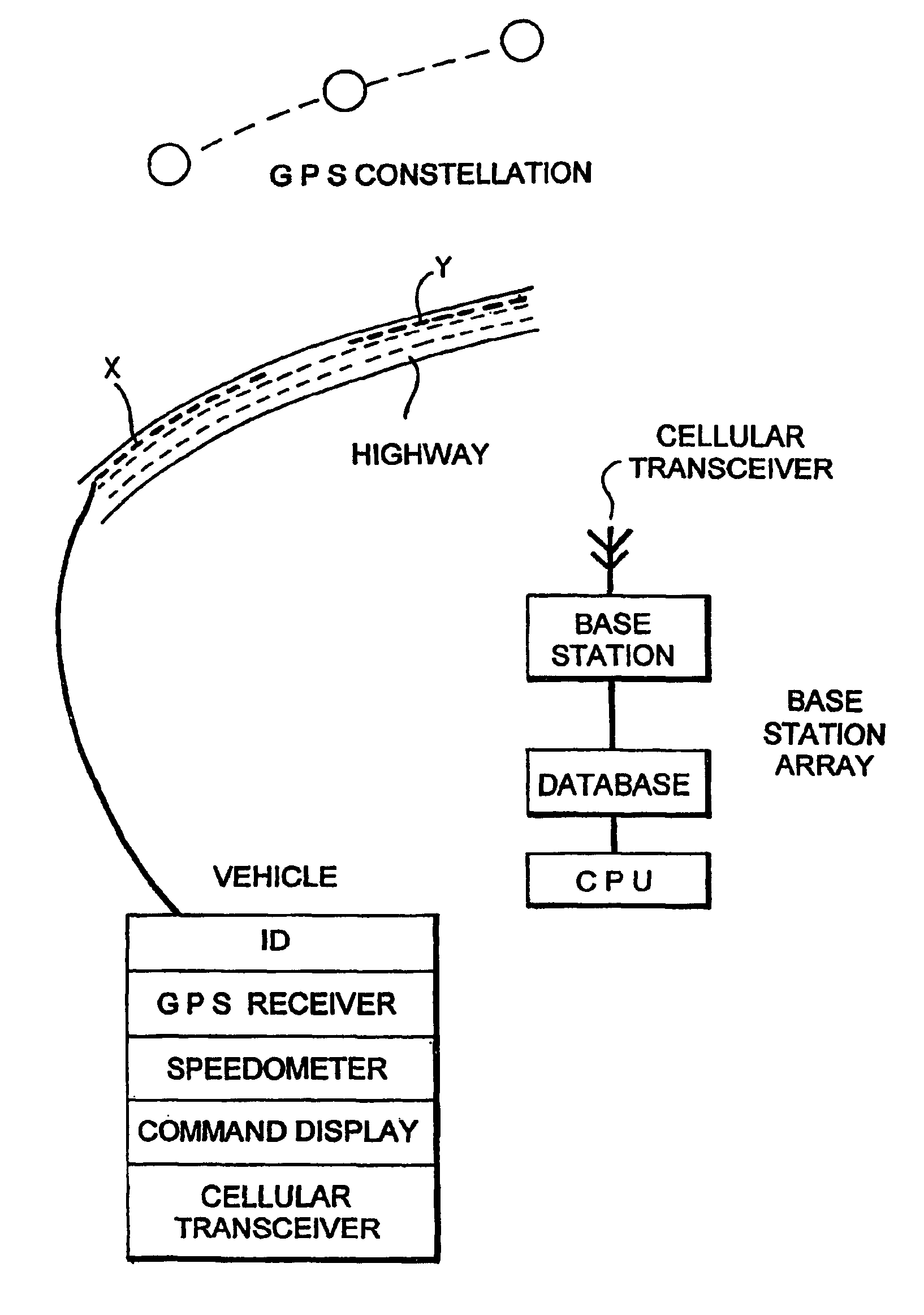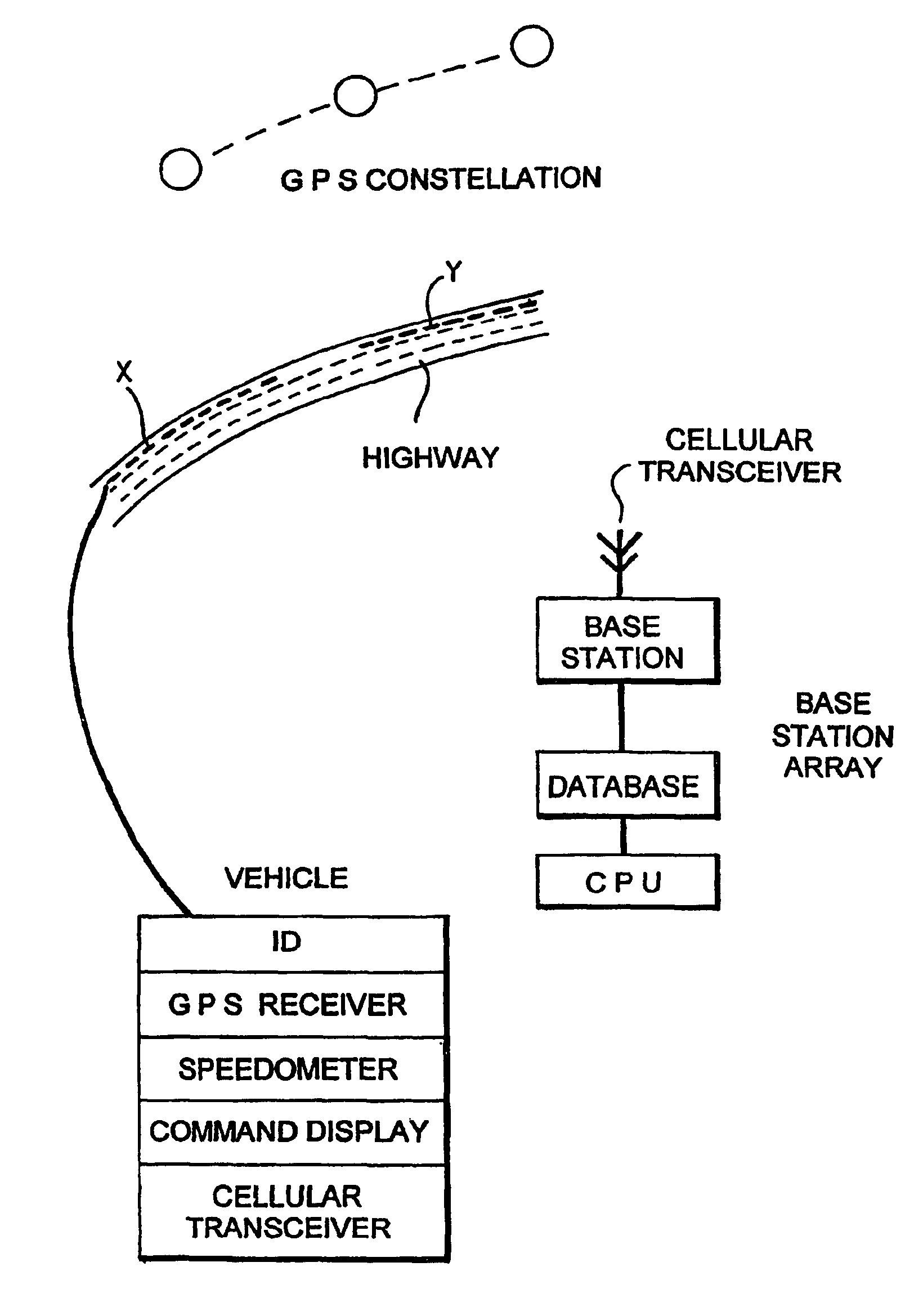Highway vehicular traffic flow control
a technology for vehicular traffic and highways, applied in traffic control systems, position/direction control, analog and hybrid computing, etc., can solve the problems of inability to absorb extant traffic volume pressure, multiple vehicle collisions on the carriageway, and slow down, and achieve the effect of increasing the overall flow of traffi
- Summary
- Abstract
- Description
- Claims
- Application Information
AI Technical Summary
Benefits of technology
Problems solved by technology
Method used
Image
Examples
example 1
[0038]A capsule A of vehicles comprising twenty five cars of various sizes and types is advancing along a lane of a three-lane carriageway at a speed of 59 mph. The capsule is lead by a car C1 (having a speed of 59 mph). The capsule occupies the outside lane of the carriageway. Beyond the head of the capsule is the tail car C2 of a further capsule B advancing at a speed of 64 mph. Car C1 has signalled its position, speed and essential ID (including type and registration details) to a base station as has car C2 and the other cars in the capsule and the base station has determined the required vehicle module lengths and the excess space if any between the vehicles in the capsule at the respective vehicle speeds. The base station has further determined that the capsule A is lagging the capsule B by 0.6 miles.
[0039]The base station signals car C1 to display a command to increase speed to a limit, which will be 70 mph in the case of UK highway law, or to pull over to the centre lane. Car...
example 2
[0040]A capsule A1 of vehicles has the composition of capsule A in Example 1 except that one of the vehicles is a truck T12 positioned at position 12 in the capsule.
[0041]The capsule is advancing in the outside lane of a three-lane carriageway at a speed of 53 mph. Capsule B advances away from the head vehicle in capsule A1 at a speed of 64 mph. The instantaneous lag of capsule A1 to the rear of capsule B is 0.6 miles.
[0042]The lead vehicle A1 in capsule A1 is signalled by the base station to increase speed to a limit equal to the approximate maximum for cars on dual-carriageway roads (eg 70 mph) or to pull over. Once it has done either, the base station is programmed successively to signal the following vehicles capable of the limit speed to do the same, transmitting such signals in response to a trigger operating when the distance between a signalled vehicle and the next in sequence along the travel path of the latter reaches a predetermined threshold or when the signalled vehicle...
example 3
[0043]Two traffic capsules A and B are travelling on a highway as noted in Example 1 but there are also Capsules C to J ahead of Capsule B forming a total of five pairs of capsules all related to one another as are Capsules A and B in Example 1 and each capsule pair being spaced from the next by 0.7 miles. The capsules travel in the outer lane of the southbound carriageway of the highway. In the northbound carriageway, an accident has occurred and the traffic there is in stasis. As Capsule J approaches the virtual constriction represented by the stationary traffic in the northbound carriageway, slow-down will ordinarily begin to occur as the accident spectacle is observed by a portion of the drivers in the outer lane of the southbound carriageway. The stasis in the northbound carriageway has, however, been recognised by the base station as a result of signals received thereby (eg from slow vehicles in that carriageway). Its response is to reconfigure the virtual models for the Capsu...
PUM
 Login to View More
Login to View More Abstract
Description
Claims
Application Information
 Login to View More
Login to View More - R&D
- Intellectual Property
- Life Sciences
- Materials
- Tech Scout
- Unparalleled Data Quality
- Higher Quality Content
- 60% Fewer Hallucinations
Browse by: Latest US Patents, China's latest patents, Technical Efficacy Thesaurus, Application Domain, Technology Topic, Popular Technical Reports.
© 2025 PatSnap. All rights reserved.Legal|Privacy policy|Modern Slavery Act Transparency Statement|Sitemap|About US| Contact US: help@patsnap.com


